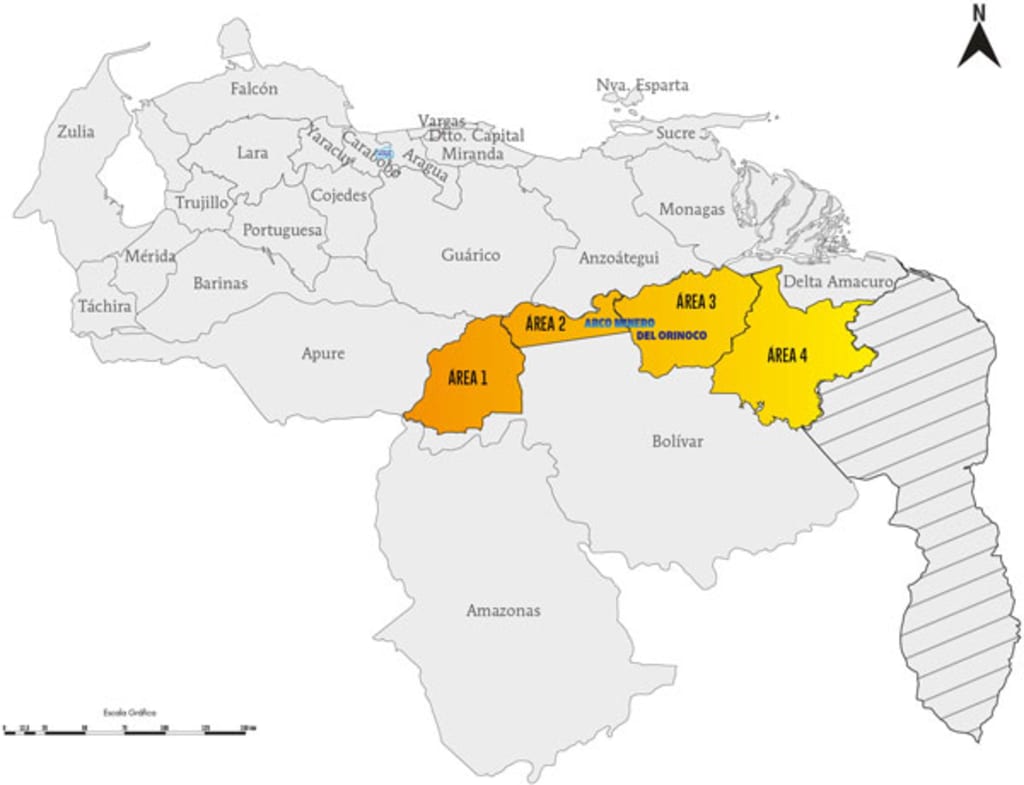Venezuela and the Struggle for Gold
The "Arco Minero del Orinoco" (AMO) was officially created on February 24th, 2016 as the National Strategic Development Zone Arco Minero del Orinoco.

The "Arco Minero del Orinoco" is an area rich in mineral resources that the Republic of Venezuela has been exploiting since 2017; it occupies mostly the north of the Bolivar state and to a lesser extent the northeast of the Amazonas state and part of the Delta Amacuro state. 7000 tons of gold, copper, diamond, coltan, iron, bauxite and other minerals can be found here.
The "Arco Minero del Orinoco" covers an area of 111,843.70 km², that is 12.2% of the Venezuelan territory; doubling the Orinoco oil belt.
According to Roberto Mirabal, former minister of the Popular Power of Ecological Mining Development, the "Arco Minero del Orinoco" has a potential of about 2 trillion dollars, which in sixty percent will be destined to Venezuela's social programs.
The Venezuelan Academy of Physical, Mathematical and Natural Sciences, the Venezuelan Society of Ecology, the Association of Archaeologists of Venezuela (AAAV) and the Venezuelan National Assembly have publicly expressed their concern at the failure to comply with environmental and socio-cultural impact studies, as well as the violation of prior consultation rights in indigenous communities, cultural and natural heritage and national sovereignty.
Venezuela And The Struggle For Gold

On February 24th, 2016, through decree 2.248 of the Official Gazette 40.855, the creation of the National Strategic Development Zone Arco Minero del Orinoco was decreed. Likewise, the decree included certifying and quantifying the mining reserves of this zone and, in addition, the Mining Engine of the Bolivarian Economic Agenda was activated.
On August 5th, 2016, the Minister of Defense and Strategic Operational Commander, Vladimir Padrino López, announced that "a special unit will be activated for the Orinoco Mining Arc."
On September 7th, 2016, the Minister for Ecological Mining Development, Roberto Mirabal, reported that the exploration stage of The "Arco Minero del Orinoco" had begun and stated that "all transnationals in the Mining Arc must comply with the laws of the State."
It consists of four large areas:
Area 1. This is the westernmost area up to the Cuchivero River, where bauxite, coltan, rare soils and diamonds predominate.
Area 2. Between the Cuchivero River and the Aro River, with predominance of iron, non-metallic minerals and alluvial gold.
Area 3. Between the Aro river and the eastern limit of the Arco Minero; gold, iron and bauxite predominate.
Area 4. Extension of the Arco Minero in the area of Imataca, where gold, copper, kaolin and dolomite predominate.
"Pemones," the indigenous ethnicity that rebelled against Maduro

On February 23th, 2019, when the failed attempt to introduce humanitarian aid from Colombia and Brazil into Venezuela took place, several violent events took place throughout the country.
The worst news came from Santa Elena de Uairén, on the border between Venezuela and Brazil. So far eight people have died as a result of the clashes that day, according to the organization "Foro Penal."
After the events, the Inter-American Commission on Human Rights (IACHR) warned that the Pemón people "find themselves in a situation of gravity and urgency, since their rights to life and personal integrity are at risk of irreparable harm.
The "Pemón" people are an indigenous ethnic group that live in the southeastern part of the state of Bolívar in Venezuela, on the border with Guyana and Brazil.
It is estimated that there are about 30,000 people of this ethnic group and are basically divided into three different groups: Taurepan, Arekuna and Kamarakoto, depending on the area of the region in which they live.
Although they have been living under their own norms and customs for several centuries, it was last December when the problems between the ethnic group and the government began.
According to El Espectador, it all began on December 8th, 2018, when an area of the indigenous community was declared a "Zone of National Strategic Development" in order to exploit the mineral resources of the area. The riots between the military and civilians resulted in the death of the young Charly Peñaloza.
"On December 8th, 2018, during the operation, the young indigenous Charly Peñaloza was assassinated, and three other members of the Pemón indigenous people were injured.
According to testimonies of the survivors and declarations of the Council of General Chiefs of the Pemón People, none of them were armed," said Amnesty International in a report.
Next day, December 9th, 2018, "officials of the armed forces closed all accesses to Canaima National Park, preventing the free transit of indigenous people in their traditional territory, and proceeded to attack with acts of violence and harassment the community of Canaima using tear gas bombs, bursts of fire with caliber machine guns, and helicopter overflights.
According to local media reports, Peñaloza fell while defending other indigenous people who had been attacked with war weapons by an undercover operation in which, in addition to the DGCIM, media from the Corporación Eléctrica Nacional (Corpoelec), the Venezuelan electricity company, participated.
Venezuela And The Struggle For Gold

The "Arco Minero del Orinoco" generated a new shipment of gold to the coffers of the Central Bank of Venezuela, this time the cargo reached 749.67 kilograms of fine gold from the small and large mining of the state of Bolivar.
This new shipment is the second in quantity, only surpassed by the seventh shipment made July 28, 2018, which was 769 kilograms.
The process of buying gold from small and medium miners, in addition to the contribution of large mining, occurs as part of a negotiation with competitive prices in the gold market.
The first shipment of gold was 238 kilos, and then during the month of May made two shipments of 313 and 453. In June there were two shipments of 250 and 577 kilograms, while in July there were two shipments, one of 577 and another of 769.
Then another of 524.42 kilograms was carried out, while in the month of September 476.09 kg were shipped. In October, two dispatches were sent to the Central Bank of Venezuela (BCV), one of 640.69 kilograms and the other of 594.21 kg.
The last shipment reached 5,992.05 kilograms of fine gold, which represents almost 220 million euros for the national economy, which has a good projection before the end of 2019.
About the Creator
HowToFind .com
More info at https://howtofind.com






Comments
There are no comments for this story
Be the first to respond and start the conversation.